重庆医科大学:《病理学》课程英文试卷(试题)
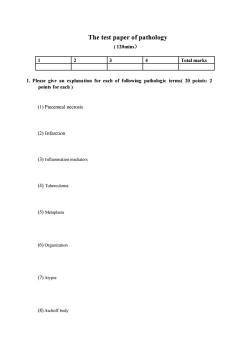
The test paper of pathology (120mins) 1 2 3 4 Total marks 1.Please give an explanation for each of following pathologic terms(20 points:2 points for each) (1)Piecemeal necrosis (2)Infarction (3)Inflammation mediators (4)Tuberculoma (5)Metaplasia (6)Organization (7)Atypia (8)Aschoff body
The test paper of pathology ( 120mins) 1 2 3 4 Total marks 1. Please give an explanation for each of following pathologic terms( 20 points: 2 points for each ) (1) Piecemeal necrosis (2) Infarction (3) Inflammation mediators . (4) Tuberculoma (5) Metaplasia (6) Organization (7) Atypia (8) Aschoff body
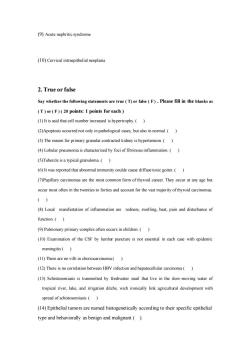
(9)Acute nephritic syndrome (10)Cervical intraepithelial neoplasia 2.True or false Say whether the following statements are true(T)or false(F).Please fill in the blanks as (T)or(F)(20 points:I points for each) (1)It is said that cell number increased is hypertrophy.( (2)Apoptosis occurred not only in pathological cases,but as in normal.( (3)The reason for primary granular contracted kidney is hypertension.( (4)Lobular pneumonia is characterized by foci of fibrinous inflammation.( (5)Tubercle is a typical granuloma.( (6)It was reported that abnormal immunity coulde cause diffuse toxic goiter.( (7)Papillary carcinomas are the most common form of thyroid cancer.They occur at any age but occur most often in the twenties to forties and account for the vast majority of thyroid carcinomas. (8)Local manifestation of inflammation are redness,swelling.heat.pain and disturbance of function.() ()Pulmonary primary complex often occurs in children.( (10)Examination of the CSF by lumbar puncture is not essential in each case with epidemic meningitis() (11)There are no villi in choriocarcinoma() (12)There is no correlation between HBV infection and hepatocellular carcinoma() (13)Schistosomiasis is transmitted by freshwater snail that live in the slow-moving water of tropical river,lake,and irrigation ditchs,wich ironically link agricultural development with spread of schistosomiasis ( (14)Epithelial tumors are named histogenetically according to their specific epithelial type and behaviorally as benign and malignant ()
(9) Acute nephritic syndrome (10) Cervical intraepithelial neoplasia 2. True or false Say whether the following statements are true ( T) or false ( F ) . Please fill in the blanks as ( T ) or ( F ) ( 20 points: 1 points for each ) (1) It is said that cell number increased is hypertrophy. ( ) (2)Apoptosis occurred not only in pathological cases, but also in normal. ( ) (3) The reason for primary granular contracted kidney is hypertension. ( ) (4) Lobular pneumonia is characterized by foci of fibrinous inflammation. ( ) (5)Tubercle is a typical granuloma. ( ) (6) It was reported that abnormal immunity coulde cause diffuse toxic goiter. ( ) (7)Papillary carcinomas are the most common form of thyroid cancer. They occur at any age but occur most often in the twenties to forties and account for the vast majority of thyroid carcinomas. ( ) (8) Local manifestation of inflammation are redness, swelling, heat, pain and disturbance of function. ( ) (9) Pulmonary primary complex often occurs in children. ( ) (10) Examination of the CSF by lumbar puncture is not essential in each case with epidemic meningitis ( ) (11) There are no villi in choriocarcinoma ( ) (12) There is no correlation between HBV infection and hepatocellular carcinoma ( ) (13) Schistosomiasis is transmitted by freshwater snail that live in the slow-moving water of tropical river, lake, and irrigation ditchs, wich ironically link agricultural development with spread of schistosomiasis ( ) (14) Epithelial tumors are named histogenetically according to their specific epithelial type and behaviorally as benign and malignant ( )
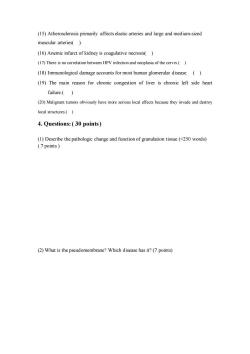
(15)Atherosclerosis primarily affectselastic arteries and large and medium-sized muscular arteries(). (16)Anemic infarct of kidney is coagulative necrosis( (17)There is no correlation between HPV infection and neoplasia of the cervix() (18)Immunological damage accounts for most human glomerular disease.( (19)The main reason for chronic congestion of liver is chronic left side heart failure.() (20)Malignant tumors obviously have more serious local effects because they invade and destroy local structures.() 4.Questions:(30 points) (1)Describe the pathologic change and function of granulation tissue(250 words) (7 points) (2)What is the pseudomembrane?Which disease has it?(7 points)
(15) Atherosclerosis primarily affects elastic arteries and large and medium-sized muscular arteries( ). (16) Anemic infarct of kidney is coagulative necrosis( ) (17) There is no correlation between HPV infection and neoplasia of the cervix ( ) (18) Immunological damage accounts for most human glomerular disease. ( ) (19) The main reason for chronic congestion of liver is chronic left side heart failure.( ) (20) Malignant tumors obviously have more serious local effects because they invade and destroy local structures.( ) 4. Questions: ( 30 points ) (1) Describe the pathologic change and function of granulation tissue (<250 words) ( 7 points ) (2) What is the pseudomembrane? Which disease has it? (7 points)
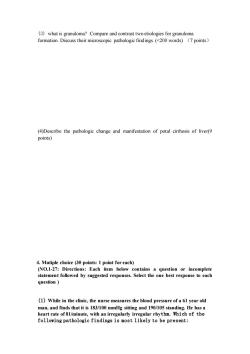
(3)what is granuloma?Compare and contrast two etiologies for granuloma formation.Discuss their microscopic pathologic findings.(200 words)(7 points) (4)Describe the pathologic change and manifestation of potal cirrhosis of liver(9 points) Directions:Each item below contains a question or incomplete statement followed by suggested responses.Select the one best response to each question (1)While in the clinic,the nurse measures the blood pressure of a 61 year old following pathologic findings is most likely to be present:
(3) what is granuloma? Compare and contrast two etiologies for granuloma formation. Discuss their microscopic pathologic findings. (<200 words) (7 points) (4)Describe the pathologic change and manifestation of potal cirrhosis of liver(9 points) 4. Mutiple choice (30 points: 1 point for each) (NO.1-27: Directions: Each item below contains a question or incomplete statement followed by suggested responses. Select the one best response to each question ) (1) While in the clinic, the nurse measures the blood pressure of a 61 year old man, and finds that it is 183/100 mmHg sitting and 190/105 standing. He has a heart rate of 81/minute, with an irregularly irregular rhythm. Which of the following pathologic findings is most likely to be present:
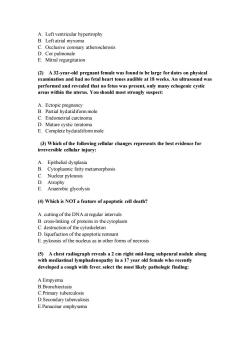
A.Left ventricular hypertrophy B.Left atrial myxoma Occlusive coronary atherosclerosis D.Cor pulmonale E.Mitral regurgitation (2)A 32-year-old pregnant female was found to be large for dates on physical examination and had no fetal heart tones audible at 18 weeks.an ultrasound was performe and revealed us was present,only many echogenic cystic areas wi the uterus.You sh ould most strongly suspect A.Ectopic pregnancy B partial hydatidiform mole C.Endometrial carcinoma D.Mature cystic te m Complete hydatidiform mole (3)Which of the following cellular changes represents the best evidence for irreversible cellular injury A.Epithelial dysplasia B.Cytoplasmic fatty metamorphosis ar pyknosis D Atrophy E.Anaerobic glycolysis (4)Which is NOT a feature of apoptotic cell death? A.cutting of the DNA at regular intervals B.cross-linkingo proteins in the cytoplasm C.destruction of the cytoskeleton D.liquefaction of the apoptotic remnant E.pyknosis of the nucleus as in other forms of necrosis A chest ra nh ogra reveals s a2 cm ight mid-lu ng subpeural nodule along with mediastinal lymphadenopathy in a 17 year old female who recently developed a cough with fever.select the most likely pathologic finding: A empvema B Brone iectasis C.Primary tuberculosi D.Secondary tuberculosis E.Panacinar emphysema
A. Left ventricular hypertrophy B. Left atrial myxoma C. Occlusive coronary atherosclerosis D. Cor pulmonale E. Mitral regurgitation (2) A 32-year-old pregnant female was found to be large for dates on physical examination and had no fetal heart tones audible at 18 weeks. An ultrasound was performed and revealed that no fetus was present, only many echogenic cystic areas within the uterus. You should most strongly suspect: A. Ectopic pregnancy B. Partial hydatidiform mole C. Endometrial carcinoma D. Mature cystic teratoma E. Complete hydatidiform mole (3) Which of the following cellular changes represents the best evidence for irreversible cellular injury: A. Epithelial dysplasia B. Cytoplasmic fatty metamorphosis C. Nuclear pyknosis D. Atrophy E. Anaerobic glycolysis (4) Which is NOT a feature of apoptotic cell death? A. cutting of the DNA at regular intervals B. cross-linking of proteins in the cytoplasm C. destruction of the cytoskeleton D. liquefaction of the apoptotic remnant E. pyknosis of the nucleus as in other forms of necrosis (5) A chest radiograph reveals a 2 cm right mid-lung subpeural nodule along with mediastinal lymphadenopathy in a 17 year old female who recently developed a cough with fever. select the most likely pathologic finding: A.Empyema B.Bronchiectasis C.Primary tuberculosis D.Secondary tuberculosis E.Panacinar emphysema
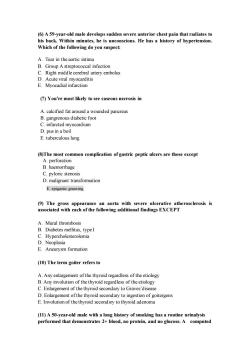
(6)A 59-vear-old male develop sudden seve ere anterior chest pain that radiates to his back. Within minutes,he is unconscious He hasa history of hypertension. Which of the following do you suspect: A.Tear in the aortic intima B.Group A streptococcal infection C.Right middle cerebral artery embolus D Ac ute viral rditis E.Myo (7)You're most likely to see caseous necrosis in A.calcified fat around a wounded pancreas B.angrenous diabeti foot C.infarcted m ocardium D.pus in a boil E.tuberculous lung (8)The most common complication of gastric peptic ulcers are those except B.haemorrhage C.pyloric stenosis D.malignant transformation E.epigastic gnawing (9)The gross appearance an aorta with severe ulcerative atherosclerosis is associated with each of the following additional findings EXCEPT A Mural thrombosis B.Diabetes C.Hypercholesterolemia D.Neoplasia E.Aneurysm formation (10)The term goiter refers to A.Any enlargement of the thyroid regardless of the etiology B.Any involution of the thyroid regardless of the etiology C.Enlargement of the thyroid secondary to Graves'disease D.Enlar yroid secondary to ingestion of goitergens id adenoma (11)A 50-year-old male with a long history of smoking has a routine urinalysis performed that demonstrates 2+blood,no protein,and no glucose.A computed
(6) A 59-year-old male develops sudden severe anterior chest pain that radiates to his back. Within minutes, he is unconscious. He has a history of hypertension. Which of the following do you suspect: A. Tear in the aortic intima B. Group A streptococcal infection C. Right middle cerebral artery embolus D. Acute viral myocarditis E. Myocadial infarction (7) You're most likely to see caseous necrosis in A. calcified fat around a wounded pancreas B. gangrenous diabetic foot C. infarcted myocardium D. pus in a boil E. tuberculous lung (8)The most common complication of gastric peptic ulcers are those except A. perforation B. haemorrhage C. pyloric stenosis D. malignant transformation E. epigastic gnawing (9) The gross appearance an aorta with severe ulcerative atherosclerosis is associated with each of the following additional findings EXCEPT A. Mural thrombosis B. Diabetes mellitus, type I C. Hypercholesterolemia D. Neoplasia E. Aneurysm formation (10) The term goiter refers to A. Any enlargement of the thyroid regardless of the etiology B. Any involution of the thyroid regardless of the etiology C. Enlargement of the thyroid secondary to Graves’disease D. Enlargement of the thyroid secondary to ingestion of goitergens E. Involution of the thyroid secondsry to thyroid adenoma (11) A 50-year-old male with a long history of smoking has a routine urinalysis performed that demonstrates 2+ blood, no protein, and no glucose. A computed
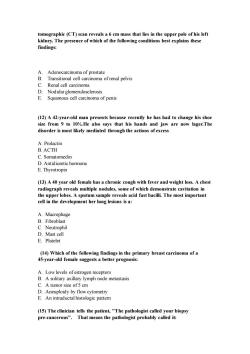
tomographic(CT)scan reveals a6cm mass that lies in the upper pole of his left The presence of which of the owing conditions best explains these findings: A.Adenocarcinoma of prostate B.Transitional cell carcinoma ofrenal pelvis Renal cell carcinoma 0 Nodulargl clerosis E Squamous cell carcinoma of penis (12)A 42-year-old man presents because recently he has had to change his shoe size from 9 to 10%.He also says that his hands and jaw are now lager.The disorder is most likely mediated through the actions of exc A.Prolactin B.ACTH C Somatomedin D.Antidiuretic hormone E.Thyrotropin (13)A 40 year old female has a chronic cough with fever and weight loss.A chest radiograph reveals multiple nodules,some of which demonstrate cavitation in the upper lobes.A sputum sample reveals acid fast bacilli.The most important cell in the development her lung lesions is a: a macronhage B Fibroblast Neutrophil D.Mast cell E.Platelet (14)Which of the following findings in the primary breast carcinoma of a 45-year-old female suggests a bette 合人 C.A tumor size of 5 cm D.Aneuploidy by flow cytometry E.An intraductal histologic pattern (15)The clinician tells the patient,"The pathologist called rbiopsy pre-cancerous' That means the pathologist probably called it:
tomographic (CT) scan reveals a 6 cm mass that lies in the upper pole of his left kidney. The presence of which of the following conditions best explains these findings: A. Adenocarcinoma of prostate B. Transitional cell carcinoma of renal pelvis C. Renal cell carcinoma D. Nodular glomerulosclerosis E. Squamous cell carcinoma of penis (12) A 42-year-old man presents because recently he has had to change his shoe size from 9 to 10½.He also says that his hands and jaw are now lager.The disorder is most likely mediated through the actions of excess A. Prolactin B. ACTH C. Somatomedin D. Antidiuretic hormone E. Thyrotropin (13) A 40 year old female has a chronic cough with fever and weight loss. A chest radiograph reveals multiple nodules, some of which demonstrate cavitation in the upper lobes. A sputum sample reveals acid fast bacilli. The most important cell in the development her lung lesions is a: A. Macrophage B. Fibroblast C. Neutrophil D. Mast cell E. Platelet (14) Which of the following findings in the primary breast carcinoma of a 45-year-old female suggests a better prognosis: A. Low levels of estrogen receptors B. A solitary axillary lymph node metastasis C. A tumor size of 5 cm D. Aneuploidy by flow cytometry E. An intraductal histologic pattern (15) The clinician tells the patient, "The pathologist called your biopsy pre-cancerous". That means the pathologist probably called it:
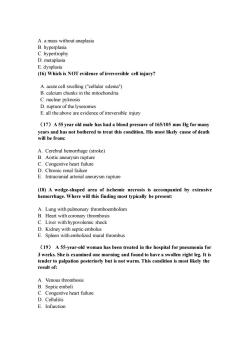
A.a mass without anaplasia B.hyperplasia C.hypertrophy D metaplasia E dysplasia (16)Which is NOT evidence of irreversible cell injury? A.acute cell swelling ("cellular edema") B.calcium chunks in the mitochondria C.nuclear pyknosis D.rupture ofthe lysosomes E.all the above are evidence of irreversible injury (17)A55 year old male has had a blood pressure of 165/105 mm Hg for many vears and has not bothered to treat this condition.His most likely cause of death will be from: A.Cerebral hemorrhage(stroke) Congestive he t failure D.Chronic renal failure E.Intracranial arterial aneurysm rupture (18)A wedge-shaped area of ischemic necrosis is accompanied by extensive hemorrhage.Wher e will this finding most typically be prese t Lung with pulmonary thromboembolism B.Heart with coronary thrombosis C.Liver with hypovolemic shock D.Kidney with septic embolus E Spleen olized mura al thrombus (19)A 55-year-old woman has been treated in the hospital for pneumonia for 3 weeks.She is examined one morning and found to have a swollen right leg.It is tender to palpation posteriorly but is not warm.This condition is most likely the result of: A.Venous thrombosis B.Septic emboli D.Cellulitis E.Infarction
A. a mass without anaplasia B. hyperplasia C. hypertrophy D. metaplasia E. dysplasia (16) Which is NOT evidence of irreversible cell injury? A. acute cell swelling ("cellular edema") B. calcium chunks in the mitochondria C. nuclear pyknosis D. rupture of the lysosomes E. all the above are evidence of irreversible injury (17)A 55 year old male has had a blood pressure of 165/105 mm Hg for many years and has not bothered to treat this condition. His most likely cause of death will be from: A. Cerebral hemorrhage (stroke) B. Aortic aneurysm rupture C. Congestive heart failure D. Chronic renal failure E. Intracranial arterial aneurysm rupture (18) A wedge-shaped area of ischemic necrosis is accompanied by extensive hemorrhage. Where will this finding most typically be present: A. Lung with pulmonary thromboembolism B. Heart with coronary thrombosis C. Liver with hypovolemic shock D. Kidney with septic embolus E. Spleen with embolized mural thrombus (19) A 55-year-old woman has been treated in the hospital for pneumonia for 3 weeks. She is examined one morning and found to have a swollen right leg. It is tender to palpation posteriorly but is not warm. This condition is most likely the result of: A. Venous thrombosis B. Septic emboli C. Congestive heart failure D. Cellulitis E. Infarction
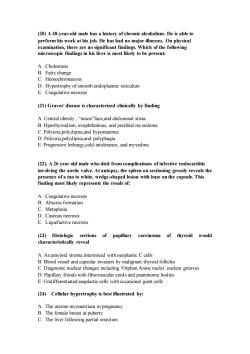
(20)A 48-year-old male has a history of chronic alcoholism.He is able to perform his work at his job.He has physical examination,there are significant findings.Which of th following microscopic findings in his liver is most likely to be present: A.Cholestasis B.Fatty change C.Hemochromatosis D.Hyper rophy of smooth endoplasmic reticulum E.Coagulative necrosis (21)Graves'disease is characterized clinically by finding A.Central obesity"moon"face,and abdomir nal striae C.Polyuria.polydipsia and hyponatemia D.Polyuria,polydipsia,and polyphagia E.Progressive lethargy,cold intolerance,and myxedma involving the aortic valve.At autopsy,the spleen on sectioning grossly reveals the presence of a tan to white,wedge-shaped lesion with base on the capsule.This finding most likely represents the result of: a Coagulative necrosis B.Abscess formation C.Metaplasia D.Caseous necrosis E.Liquefactive necrosis (23)Histologic sections of papillary carcinoma of thyroid would A.An amyloid stroma intermixed with neoplastic C cells B.Blood vessel and capsular invasion by malignant thyroid follicles C.Diagnostic nuclear changes includingOrphan Annie nuclei,nuclear grooves D.Papillary fronds with fibrova cula cords and p mom a bodie E.Undifferentiated anaplastic cells with occasional giant cell (24)Cellular hypertrophy is best illustrated by: A.The uterine myometrium in pregnancy B.The female breast at puberty C.The liver following partial resection
(20) A 48-year-old male has a history of chronic alcoholism. He is able to perform his work at his job. He has had no major illnesses. On physical examination, there are no significant findings. Which of the following microscopic findings in his liver is most likely to be present: A. Cholestasis B. Fatty change C. Hemochromatosis D. Hypertrophy of smooth endoplasmic reticulum E. Coagulative necrosis (21) Graves’ disease is characterized clinically by finding A. Central obesity , “moon”face,and abdominal striae B. Hperthyroidism, exophthalmus, and pretibial myxedema C. Polyuria,polydipsia,and hyponatemia D. Polyuria,polydipsia,and polyphagia E. Progressive lethargy,cold intolerance, and myxedma (22). A 26 year old male who died from complications of infective endocarditis involving the aortic valve. At autopsy, the spleen on sectioning grossly reveals the presence of a tan to white, wedge-shaped lesion with base on the capsule. This finding most likely represents the result of: A. Coagulative necrosis B. Abscess formation C. Metaplasia D. Caseous necrosis E. Liquefactive necrosis (23) Histologic sections of papillary carcinoma of thyroid would characteristically reveal A. An amyloid stroma intermixed with neoplastic C cells B. Blood vessel and capsular invasion by malignant thyroid follicles C. Diagnostic nuclear changes including ‘Orphan Annie nuclei’,nuclear grooves D. Papillary fronds with fibrovascular cords and psammoma bodies E. Undifferentiated anaplastic cells with occasional giant cells (24) Cellular hypertrophy is best illustrated by: A. The uterine myometrium in pregnancy B. The female breast at puberty C. The liver following partial resection

D.The ovary following meno E.The cervix with chronic inflammation (25)The definition of the nephrotic syndrome is based upon the finding of: A.No inflammation in a urinalysis specimen B.Proteinuria>3.5 gm/24 hours C.Hematuria with>10 RBC/hpf ia in ass E Renal tub r epithelial cel and cast No:26 and 27:For each of the following descriptions,select the most likely cell: (26)Several foci of endometrial glands and stroma are seen on biopsies of lesions ranging in size from 0.1 to 0.5 cm seen laparoscopically on the uterine serosa of a 30 yearo woman with a history of dyspareua forseveral years but o vaginal bleeding.The uterus and adnexae are norm nal in size: (27)An enlarged,nodular uterus is felt on bimanual examination ofa 40-year-old who has had metrorrhagia for the past six months.The cervix appears normal: A Adenomvosis B.Endometriosis Endocervical polyp D.Leiomyomata E.Endometritis No:28-30:For each of the following descriptions,select the most likely cell: (28).What cells that circulates in the bloodstream can migrate into tissues and assume a phagocytic function for an extended period of tim (29).The Langhans type of this cell is found in mycobacterial granulomas. (30).What cell is instrumental in collagen production. A Polymorphonuclear leukocyte and Monocyte B.Multinucleated giant cell C.Fibroblast D.Eosinophil F.Plasma cell
D. The ovary following menopause E. The cervix with chronic inflammation (25) The definition of the nephrotic syndrome is based upon the finding of: A. No inflammation in a urinalysis specimen B. Proteinuria >3.5 gm/24 hours C. Hematuria with >10 RBC/hpf D. Lipiduria in association with hypercholesterolemia E. Renal tubular epithelial cells and casts No: 26 and 27: For each of the following descriptions, select the most likely cell: (26) Several foci of endometrial glands and stroma are seen on biopsies of lesions ranging in size from 0.1 to 0.5 cm seen laparoscopically on the uterine serosa of a 30 year old woman with a history of dyspareunia for several years, but no vaginal bleeding. The uterus and adnexae are normal in size: (27) An enlarged, nodular uterus is felt on bimanual examination of a 40-year-old who has had metrorrhagia for the past six months. The cervix appears normal: A. Adenomyosis B. Endometriosis C. Endocervical polyp D. Leiomyomata E. Endometritis No: 28-30: For each of the following descriptions, select the most likely cell: (28). What cells that circulates in the bloodstream can migrate into tissues and assume a phagocytic function for an extended period of time. (29). The Langhans type of this cell is found in mycobacterial granulomas. (30). What cell is instrumental in collagen production. A. Polymorphonuclear leukocyte and Monocyte. B. Multinucleated giant cell C. Fibroblast D. Eosinophil F. Plasma cell
按次数下载不扣除下载券;
注册用户24小时内重复下载只扣除一次;
顺序:VIP每日次数-->可用次数-->下载券;
- 重庆医科大学:《病理学》课程作业习题(英文,无答案).doc
- 重庆医科大学:《病理学》课程教学实习指导(英文).doc
- 重庆医科大学:《病理学》课程课程教学大纲 A Teaching Outline for Pathology Course.doc
- 重庆医科大学:《病理学》课程理论教学大纲(供七年制和五年制使用).doc
- 重庆医科大学:《病理学》课程教学资源(PPT课件)传染病与寄生虫病(infectious desease and parasitosis).ppt
- 重庆医科大学:《病理学》课程教学资源(PPT课件)神经系统疾病(Diseases of the CNS).ppt
- 重庆医科大学:《病理学》课程教学资源(PPT课件)内分泌系统疾病.ppt
- 重庆医科大学:《病理学》课程教学资源(PPT课件)女性生殖系统疾病(disease of female reproductive system and breast).ppt
- 重庆医科大学:《病理学》课程教学资源(PPT课件)泌尿系统疾病 Diseases of urinary system.ppt
- 重庆医科大学:《病理学》课程教学资源(PPT课件)消化系统疾病 Digestive system disease.ppt
- 重庆医科大学:《病理学》课程教学资源(PPT课件)呼吸系统疾病.ppt
- 重庆医科大学:《病理学》课程教学资源(PPT课件)心血管疾病 Diseases of Cardiovascular system.ppt
- 重庆医科大学:《病理学》课程教学资源(PPT课件)肿瘤(tumor, neoplasm).ppt
- 重庆医科大学:《病理学》课程教学资源(PPT课件)炎症 inflammation.ppt
- 重庆医科大学:《病理学》课程教学资源(PPT课件)局部血液循环障碍.ppt
- 重庆医科大学:《病理学》课程教学资源(PPT课件)绪论、细胞和组织的适应与损伤、损伤的修复.ppt
- 《病理学》课程作业习题(含参考答案).pdf
- 《病理学》课程实习指导 Guidance of Pathology.pdf
- 《病理学》课程教学大纲(五年制临床、儿科、麻醉、基础、预防、口腔医学专业使用;七年制临床、儿科、检验、物理专业使用).docx
- 《遗传与优生学》课程教学资源(课件讲稿)第8章 遗传咨询(genetic counseling).pdf
- 重庆医科大学:《病理学》课程英文试卷(答案).doc
- 重庆医科大学:《病理学》课程教学资源(授课教案)infectious disease.doc
- 重庆医科大学:《病理学》课程教学资源(授课教案)the Diseases of female genital system.doc
- 重庆医科大学:《病理学》课程教学资源(授课教案)disease of nevous system_1.doc
- 重庆医科大学:《病理学》课程教学资源(授课教案)disease of nevous system_2.doc
- 重庆医科大学:《病理学》课程教学资源(授课教案)diseases of cardiovascular system.doc
- 重庆医科大学:《病理学》课程教学资源(授课教案)diseases of respiratory system.doc
- 重庆医科大学:《病理学》课程教学资源(授课教案)disease of alimentary system.doc
- 重庆医科大学:《病理学》课程教学资源(授课教案)disease of urinary system.doc
- 重庆医科大学:《病理学》课程教学资源(授课教案)cell adaptation and injury, repair.doc
- 重庆医科大学:《病理学》课程教学资源(授课教案)tumor.doc
- 重庆医科大学:《病理学》课程教学资源(授课教案)Introduction and hemodynamic rearangment.doc
- 重庆医科大学:《病理学》课程教学资源(授课教案)inflammation.doc
- 重庆医科大学:《病理学》课程教学资源(授课教案)内分泌系统疾病.doc
- 重庆医科大学:《病理学》课程教学资源(授课教案)传染和寄生虫病.doc
- 重庆医科大学:《病理学》课程教学资源(授课教案)女性生殖系统疾病.doc
- 重庆医科大学:《病理学》课程教学资源(授课教案)神经系统疾病.doc
- 重庆医科大学:《病理学》课程教学资源(授课教案)心血管系统疾病.doc
- 重庆医科大学:《病理学》课程教学资源(授课教案)呼吸系统疾病.doc
- 重庆医科大学:《病理学》课程教学资源(授课教案)消化系统疾病.doc
